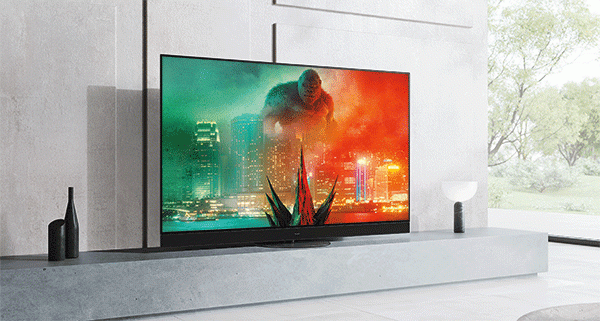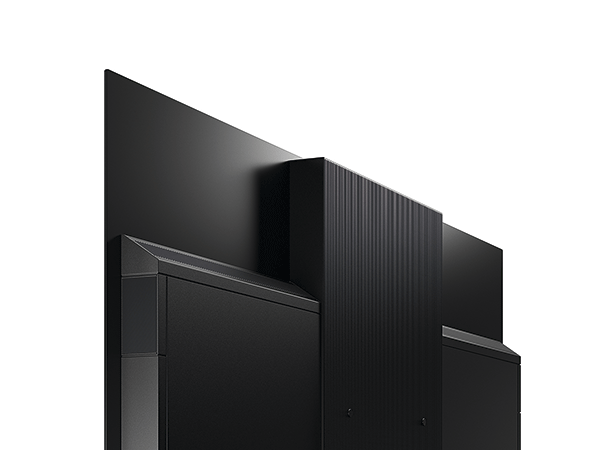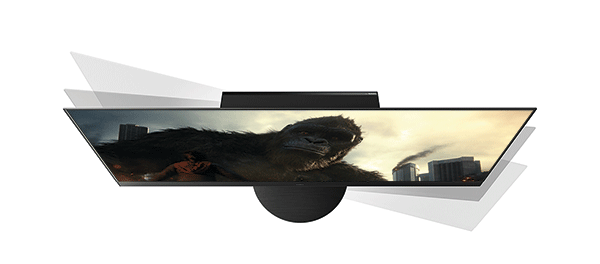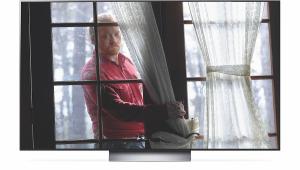Panasonic TX-55JZ2000 4K OLED TV review

 I'm watching Panasonic's TX-55JZ2000, and can’t stop looking into Arthur Curry’s eyes. The protector of the oceans, the Aquaman, is staring at Bruce Wayne, and his salty peepers seem to almost glitter. Green and blue flecks dance around pinpricks of light. They’re beautiful. This new flagship OLED screen is taking me deep. I could swim in its pictures.
I'm watching Panasonic's TX-55JZ2000, and can’t stop looking into Arthur Curry’s eyes. The protector of the oceans, the Aquaman, is staring at Bruce Wayne, and his salty peepers seem to almost glitter. Green and blue flecks dance around pinpricks of light. They’re beautiful. This new flagship OLED screen is taking me deep. I could swim in its pictures.
Panasonic has been wowing us with its Master HDR OLED Professional Edition panel for a while now, but its high-end screens have tended to fall short when it comes to some functionality. The brand may be joined at the hip with Hollywood creatives, but it’s shown little empathy for hardcore gamers, and there’s the niggling suspicion that its smart experience was just another box to check. But with the JZ2000, Panasonic has put these shortcomings behind it. This telly is an absolute belter.
Just the two of us
The JZ2000 comes in two sizes: 55in (tested here, £2,300) and 65in (£2,800) – both commanding a price premium over even well-specified rivals. As with last year's HZ2000 models, there's no super-sized version (the 77in OLED size offered by competitor LG), possibly because such a variant of its Pro panel isn’t commercially viable.
Physically, the set looks much like its predecessor, but importantly its Dolby Atmos sound system – a key selling point of this range – has been upgraded. In addition to rear-mounted upfiring speakers, this iteration also comes with matching side-firing drivers, again bolted to the back panel so that they’re unnoticeable when the TV is viewed from the front.
Panasonic calls this seven-channel configuration 360° Soundscape Pro, and rates its total amplification at a promising 125W. To help acclimatise the speaker array to your room, there's auto audio calibration – Space Tune – which measures a series of chirps and pulses via a built-in microphone. Tuning fidelity is signed-off by Technics.
In use, I found this setup delivered authentic Dolby Atmos height, while the new side-firing drivers extending width. This combo is particularly effective with live sports, where there's a real sense of spatial ambience. There’s also a tangible feeling of sonic placement with movies and multichannel TV shows.
Inevitably, you don’t get any sound from the rear. A run-through of Atmos clips revealed details entering the frame via the left- and right-side speakers, rather than coming from behind. But that's to be expected.

While the TV doesn’t do deep bass, it does deliver a stern mid-bass, and it folds down the LFE, rather than chop it off completely. The end result is one of the best executions of Dolby Atmos you’ll hear from a flatscreen, and something that turns the JZ2000 into a genuine all-rounder.
Brainier than before
Also new for 2021 is AI processing. Opt for the Auto AI preset and the screen will analyse content, and tweak sound and vision to match. The processor compares incoming images on a frame-by-frame basis, in real time, and references it with an onboard database. Genre recognition is standard – the JZ2000 knows what you’re watching.
Auto AI works well for general viewing, but I soon abandoned it when I wanted to watch a movie, as by default it engaged image smoothing. It's not that Panasonic’s Intelligent Frame Creation (IFC) engine isn’t very good – motion artefacts which used to be a common blight are now more or less gone – but I’d rather not have my movies smoothed like mash.
Connectivity is good but not best-of-breed. Of the TV's four HDMI inputs, numbers 1 and 2 are HDMI v2.1 empowered and support 4K/120Hz video. There’s also eARC on the second HDMI input (although given the nature of the set, it's unlikely to be partnered with a soundbar), plus VRR. All four HDMIs have ALLM game mode support. Measured input lag is the best I've seen from a Panasonic OLED, coming in at just 14.5ms with a 1080/60 source.
Panasonic's HDR provision, alongside that of Philips, is the best in the business, and includes ambient-sensing Dolby Vision IQ and HDR10+ Adaptive flavours. Panasonic also dovetails its 'intelligent sensing' with Filmmaker Mode, giving the cinephile standard a leg up in tricky lighting conditions.
Perhaps the biggest surprise offered by the JZ2000 is its smart platform. Previous iterations of Panasonic’s Home Screen interface have made a virtue of their relative simplicity. But here, with v6.0, we get an altogether more expansive interface. Customisable Home pins are still upfront, but content curation has improved, and there are extras, including a gallery mode, plus voice control with Google Assistant and Alexa. The streaming app selection features Netflix, Amazon Prime, BritBox and Rakuten TV, while mainstream catch-up services and copious boxsets are provided by Freeview Play. Not much of the latter is available in 4K, but Panasonic's HCX Pro AI processor is an efficient upscaler of HD fare.
Justice is served
As Aquaman’s eye’s attest (Zack Snyder’s Justice League, 4K Blu-ray), this TV's level of fine detail and nuance is often extraordinary. Colour gradations are smooth, and retaining near black detail doesn't compromise the integrity of the 4:3 film's spacious black bars. There’s 3D-style depth here.
The JZ2000 is the latest outing for Panasonic’s Master HDR OLED Professional Edition panel. Massaged by engineers to give higher average panel brightness and sparkling HDR peaks, it now faces competition from LG’s Evo panel. It’s tempting to compare the two, although the screens are aimed at rather different buyers. LG's ultra-slim G1 is intended for wall-mounting, while this Panasonic is a more well-rounded home cinema solution.
As it happens, I found the JZ2000 offering brighter specular highlights than the LG G1. With the Normal viewing mode selected, HDR peak brightness on a 5 per cent window measured at more than 900 nits. That’s more than enough to showcase most HDR grading without any need to aggressively tone map – a 1,000-nit ceiling is the standard for broadcast HDR.

The Netflix Dolby Vision presentation of Fear Street: 1994 perfectly illustrates this screen's range. As the teens disturb long dead witch Sara late at night, their headband torches ping out of the blackness, but this doesn’t impact the subtle picture info in the surrounding, eerie forest.
Opt for Panasonic's Dynamic preset, and you can pocket 950 nits, although it’s not a viewing mode I would advocate for anything other than animation. It’s just a little too oversaturated, and in other modes the JZ2000's colour delivery (tuned by Hollywood colourist Stefan Sonnenfeld) is arguably its most satisfying trait. There’s a richness to the palette which echoes the kind of viewing experience you’ll see in an IMAX with Laser or Dolby Cinema screen – vibrant and lush, but not over-exaggerated.
For subjective colour accuracy that doesn’t undersell the talents of the panel, I'd advocate the True Cinema option – or a professional calibration.
Killer combo
Overall, the JZ2000 is a brilliantly engineered 4K flagship that delivers where it counts and is priced accordingly. The 360° Soundscape Pro audio system is an entertaining simulacrum of a home theatre setup, and the brand’s My Home Screen smart platform has never looked better.
The coup de grâce, however, is the killer combo of Panasonic's OLED 'Professional Edition' panel and all-new, all-powerful HCX Pro AI processor. When it comes to fine detail, nuance, colour and sublime cinematic contrast, I'd say there really is nothing better.
HCC Verdict: 5/5
Specifications
4K: Yes. 3,840 x 2,160
HDR: Yes. HDR10+; Dolby Vision; HLG; HDR10; HDR Photo
TUNER: Yes. Freeview HD; generic satellite
CONNECTIONS: 4 x HDMI inputs; Ethernet port; 3 x USB; optical digital audio output
SOUND (CLAIMED):125W (5.1.2)
BRIGHTNESS (CLAIMED): N/A
CONTRAST RATIO (CLAIMED): N/A
4K/120 PLAYBACK: Yes
DIMENSIONS (OFF STAND): 1,227(w) x 764(h) x 69(d)mm
WEIGHT (OFF STAND): 18.5kg
FEATURES: Built-in Wi-Fi; 360° Soundscape Pro audio; HCX Pro AI Processor; Filmmaker Mode with Intelligent Sensing; Dolby Vision IQ; HDR10+ Adaptive; My Home Screen 6.0; Calman ready; HDMI v2.1 on two inputs; ALLM; VRR
 |
Home Cinema Choice #351 is on sale now, featuring: Samsung S95D flagship OLED TV; Ascendo loudspeakers; Pioneer VSA-LX805 AV receiver; UST projector roundup; 2024’s summer movies; Conan 4K; and more
|

















































